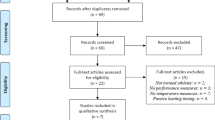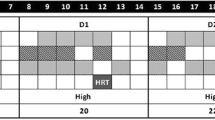Abstract
Recent research into passive heating has shown that it can enhance performance when used as; a stimulus for heat acclimation, part of regular training, or during a warm-up. However, this research is contradictory to established practices such as ice baths in the case of recovery. The current usage and understanding of passive heating within sport is unknown. This study aimed to establish the current prevalence, practices and perceptions of passive heating from athletes and sport science practitioners within sport using an online survey. Of the 343 respondents, 62% of athletes and 69% of practitioners reported using passive heating within their sport, with a greater prevalence amongst combat sport athletes or athletes competing at a higher standard (p < 0.05). The most commonly reported purpose of engaging in passive heating for athletes was recovery (66%), and for practitioners was heat acclimation (64%). Most athletes previously engaging in passive heating perceived it to be beneficial for its intended purpose (86%), providing anecdotal evidence to support its use where there currently is no scientific evidence. Moreover, transient negative consequences, such as dizziness or fatigue, were experienced by 55% of athletes highlighting the potential detrimental effects passive heating could have on training or performance that should be considered by athletes and practitioners. Therefore, this survey establishes key differences between scientific understanding and sporting practices whilst identifying areas of future development for the use of passive heating within sport.




Similar content being viewed by others
Data availability
Data can be found in the supplementary material.
References
Crandall CG, Wilson TE, Marving J et al (2008) Effects of passive heating on central blood volume and ventricular dimensions in humans. J Physiol 586:293–301. https://doi.org/10.1113/jphysiol.2007.143057
Gray SR, De Vito G, Nimmo MA et al (2006) Skeletal muscle ATP turnover and muscle fiber conduction velocity are elevated at higher muscle temperatures during maximal power output development in humans. Am J Physiol Regul Integr Comp Physiol 290:R376–R382. https://doi.org/10.1152/ajpregu.00291.2005
Laukkanen T, Kunutsor SK, Zaccardi F et al (2018) Acute effects of sauna bathing on cardiovascular function. J Hum Hypertens 32:129–138. https://doi.org/10.1038/s41371-017-0008-z
Rodrigues P, Trajano GS, Wharton L, Minett GM (2020) Muscle temperature kinetics and thermoregulatory responses to 42 °C hot-water immersion in healthy males and females. Eur J Appl Physiol. https://doi.org/10.1007/s00421-020-04482-7
Thomas KN, van Rij AM, Lucas SJE et al (2016) Substantive hemodynamic and thermal strain upon completing lower-limb hot-water immersion; comparisons with treadmill running. Temperature 3:286–297. https://doi.org/10.1080/23328940.2016.1156215
Cullen T, Clarke ND, Hill M et al (2020) The health benefits of passive heating and exercise: to what extent do the mechanisms overlap. J Appl Physiol. https://doi.org/10.1152/japplphysiol.00608.2020
Heathcote SL, Hassmén P, Zhou S, Stevens CJ (2018) Passive heating: reviewing practical heat acclimation strategies for endurance athletes. Front Physiol 9:1851. https://doi.org/10.3389/fphys.2018.01851
Thorpe RT (2021) Post-exercise recovery: cooling and heating, a periodized approach. Front Sports Act Living 3:236. https://doi.org/10.3389/fspor.2021.707503
Ihsan M, Périard JD, Racinais S (2019) Integrating heat training in the rehabilitation toolbox for the injured athlete. Front Physiol. https://doi.org/10.3389/fphys.2019.01488
Hyldahl RD, Peake JM (2020) Combining cooling or heating applications with exercise training to enhance performance and muscle adaptations. J Appl Physiol. https://doi.org/10.1152/japplphysiol.00322.2020
Faulkner SH, Ferguson RA, Gerrett N et al (2013) Reducing muscle temperature drop after warm-up improves sprint cycling performance. Med Sci Sports Exerc 45:359–365. https://doi.org/10.1249/MSS.0b013e31826fba7f
Cheng AJ, Willis SJ, Zinner C et al (2017) Post-exercise recovery of contractile function and endurance in humans and mice is accelerated by heating and slowed by cooling skeletal muscle. J Physiol (Lond) 595:7413–7426. https://doi.org/10.1113/JP274870
Barley OR, Chapman DW, Abbiss CR (2018) Weight loss strategies in combat sports and concerning habits in mixed martial arts. Int J Sports Physiol Perform 13:933–939. https://doi.org/10.1123/ijspp.2017-0715
Brito C, Roas AF, Brito I et al (2012) Methods of body-mass reduction by combat sport athletes. Int J Sport Nutr Exerc Metab 22:89–97. https://doi.org/10.1123/ijsnem.22.2.89
Giannini Artioli G, Gualano B, Franchini E et al (2010) Prevalence, magnitude, and methods of rapid weight loss among judo competitors. Med Sci Sports Exerc 42:436–442. https://doi.org/10.1249/MSS.0b013e3181ba8055
Sargeant AJ (1987) Effect of muscle temperature on leg extension force and short-term power output in humans. Eur J Appl Physiol 56:693–698. https://doi.org/10.1007/BF00424812
McGowan CJ, Thompson KG, Pyne DB et al (2016) Heated jackets and dryland-based activation exercises used as additional warm-ups during transition enhance sprint swimming performance. J Sci Med Sport 19:354–358. https://doi.org/10.1016/j.jsams.2015.04.012
Zurawlew MJ, Walsh NP, Fortes MB, Potter C (2016) Post-exercise hot water immersion induces heat acclimation and improves endurance exercise performance in the heat. Scand J Med Sci Sports 26:745–754. https://doi.org/10.1111/sms.12638
Hesketh K, Shepherd SO, Strauss JA et al (2019) Passive heat therapy in sedentary humans increases skeletal muscle capillarization and eNOS content but not mitochondrial density or GLUT4 content. Am J Physiol Heart Circ Physiol 317:H114–H123. https://doi.org/10.1152/ajpheart.00816.2018
Hafen PS, Preece CN, Sorensen JR et al (2018) Repeated exposure to heat stress induces mitochondrial adaptation in human skeletal muscle. J Appl Physiol 125:1447–1455. https://doi.org/10.1152/japplphysiol.00383.2018
Scoon GSM, Hopkins WG, Mayhew S, Cotter JD (2007) Effect of post-exercise sauna bathing on the endurance performance of competitive male runners. J Sci Med Sport 10:259–262. https://doi.org/10.1016/j.jsams.2006.06.009
Carter HH, Spence AL, Atkinson CL et al (2014) Repeated core temperature elevation induces conduit artery adaptation in humans. Eur J Appl Physiol 114:859–865. https://doi.org/10.1007/s00421-013-2817-2
Nakamura M, Yoshida T, Kiyono R et al (2019) The effect of low-intensity resistance training after heat stress on muscle size and strength of triceps brachii: a randomized controlled trial. BMC Musculoskelet Disord 20:603. https://doi.org/10.1186/s12891-019-2991-4
Naperalsky M, Ruby B, Slivka D (2010) Environmental temperature and glycogen resynthesis. Int J Sports Med 31:561–566. https://doi.org/10.1055/s-0030-1254083
Slivka D, Tucker T, Cuddy J et al (2012) Local heat application enhances glycogenesis. Appl Physiol Nutr Metab 37:247–251. https://doi.org/10.1139/h11-157
Sabapathy M, Tan F, Al Hussein S et al (2021) Effect of heat pre-conditioning on recovery following exercise-induced muscle damage. Curr Res Physiol 4:155–162. https://doi.org/10.1016/j.crphys.2021.06.002
Vaile J, Halson S, Gill N, Dawson B (2008) Effect of hydrotherapy on the signs and symptoms of delayed onset muscle soreness. Eur J Appl Physiol 102:447–455. https://doi.org/10.1007/s00421-007-0605-6
Viitasalo JT, Niemelä K, Kaappola R et al (1995) Warm underwater water-jet massage improves recovery from intense physical exercise. Eur J Appl Physiol 71:431–438. https://doi.org/10.1007/BF00635877
Skorski S, Schimpchen J, Pfeiffer M et al (2019) Effects of postexercise sauna bathing on recovery of swim performance. Int J Sports Physiol Perform 1:1–7. https://doi.org/10.1123/ijspp.2019-0333
Rissanen JA, Häkkinen A, Laukkanen J et al (2019) Acute neuromuscular and hormonal responses to different exercise loadings followed by a sauna. J Strength Cond Res. https://doi.org/10.1519/JSC.0000000000003371
Kim K, Kargl CK, Ro B et al (2021) Neither peristaltic pulse dynamic compressions nor heat therapy accelerate glycogen resynthesis after intermittent running. Med Sci Sports Exerc 53:2425–2435. https://doi.org/10.1249/MSS.0000000000002713
Vaile J, Halson S, Gill N, Dawson B (2008) Effect of hydrotherapy on recovery from fatigue. Int J Sports Med 29:539–544. https://doi.org/10.1055/s-2007-989267
Hussain JN, Greaves RF, Cohen MM (2019) A hot topic for health: results of the Global Sauna Survey. Complement Ther Med 44:223–234. https://doi.org/10.1016/j.ctim.2019.03.012
Galbreath RW, Reger W, Allison T, Butler K (1999) Exceeding recommended standards for safe hot tub use. J Safety Res 30:7–15. https://doi.org/10.1016/S0022-4375(98)00057-7
Horvath SM, Botelho SY (1949) Orthostatic hypotension following hot or cold baths. J Appl Physiol 1:586–596. https://doi.org/10.1152/jappl.1949.1.8.586
Murugappan KR, Cocchi MN, Bose S et al (2019) Case study: fatal exertional rhabdomyolysis possibly related to drastic weight cutting. Int J Sport Nutr Exerc Metab 29:68–71. https://doi.org/10.1123/ijsnem.2018-0087
Coris EE, Ramirez AM, Van Durme DJ (2004) Heat illness in athletes. Sports Med 34:9–16. https://doi.org/10.2165/00007256-200434010-00002
Greenleaf JE, Bosco JS (1969) Orthostatic intolerance after artificial heat acclimatization in physically fit subjects. Nature 222:891. https://doi.org/10.1038/222891a0
Lucas RI, Cotter JD, Morrison S, Ainslie PN (2008) The effects of ageing and passive heating on cardiorespiratory and cerebrovascular responses to orthostatic stress in humans. Exp Physiol 93:1104–1117. https://doi.org/10.1113/expphysiol.2008.042580
Allan R, Akin B, Sinclair J et al (2021) Athlete, coach and practitioner knowledge and perceptions of post-exercise cold-water immersion for recovery: a qualitative and quantitative exploration. Sport Sci Health. https://doi.org/10.1007/s11332-021-00839-3
Turner G, Fudge BW, Pringle JSM et al (2019) Altitude training in endurance running: perceptions of elite athletes and support staff. J Sports Sci 37:163–172. https://doi.org/10.1080/02640414.2018.1488383
Connor J, Egan B (2020) Comparison of hot water immersion at self-adjusted maximum tolerable temperature, with or without the addition of salt, for rapid weight loss in mixed martial arts athletes. Biol Sport 38:89–96. https://doi.org/10.5114/biolsport.2020.96947
Gutiérrez A, Mesa J, Ruiz J et al (2003) Sauna-induced rapid weight loss decrease explosive power in women but not men. Int J Sports Med 24:518–522. https://doi.org/10.1055/s-2003-42017
Zhuo M, Li J, William JH (2018) Sauna-induced fatal rhabdomyolysis. Kidney Int Rep 4:171–173. https://doi.org/10.1016/j.ekir.2018.08.008
Kirby NV, Lucas SJE, Armstrong OJ et al (2020) Intermittent post-exercise sauna bathing improves markers of exercise capacity in hot and temperate conditions in trained middle-distance runners. Eur J Appl Physiol. https://doi.org/10.1007/s00421-020-04541-z
Bezuglov E, Lazarev A, Khaitin V et al (2021) The prevalence of use of various post-exercise recovery methods after training among elite endurance athletes. Int J Environ Res Public Health 18:11698. https://doi.org/10.3390/ijerph182111698
Meyer T, Ferrauti A, Kellmann M, Pfeiffer M (2016) Regeneration im Spitzensport. Sportverlag Strauß, Köln
Petrofsky J, Berk L, Bains G et al (2017) The efficacy of sustained heat treatment on delayed-onset muscle soreness. Clin J Sport Med 27:329–337. https://doi.org/10.1097/JSM.0000000000000375
Broatch JR, Petersen A, Bishop DJ (2014) Postexercise cold water immersion benefits are not greater than the placebo effect. Med Sci Sports Exerc 46:2139–2147. https://doi.org/10.1249/MSS.0000000000000348
Cook CJ, Beaven CM (2013) Individual perception of recovery is related to subsequent sprint performance. Br J Sports Med 47:705–709. https://doi.org/10.1136/bjsports-2012-091647
Acknowledgements
The authors would like to thank all the athletes and practitioners who completed the survey as well as everyone who helped share the survey via social media.
Funding
There is no funding associated with the work featured in this article.
Author information
Authors and Affiliations
Corresponding author
Ethics declarations
Conflict of interest
No potential conflict of interest.
Ethical approval
Ethical approval was received from Coventry University Ethics committee (P119742).
Informed consent
A total of 343 participants provided informed consent via the online survey which included both consent to participate and consent that the data could be used for publication.
Additional information
Publisher's Note
Springer Nature remains neutral with regard to jurisdictional claims in published maps and institutional affiliations.
Supplementary Information
Below is the link to the electronic supplementary material.
Rights and permissions
About this article
Cite this article
Menzies, C., Clarke, N.D., Pugh, C.J.A. et al. Athlete and practitioner prevalence, practices, and perceptions of passive heating in sport. Sport Sci Health 19, 329–338 (2023). https://doi.org/10.1007/s11332-022-00954-9
Received:
Accepted:
Published:
Issue Date:
DOI: https://doi.org/10.1007/s11332-022-00954-9




